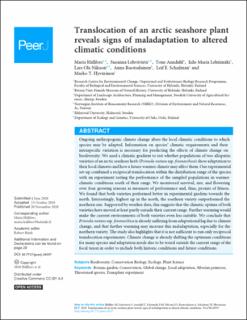| dc.description.abstract | Ongoing anthropogenic climate change alters the local climatic conditions to which species may be adapted. Information on species’ climatic requirements and their intraspecific variation is necessary for predicting the effects of climate change on biodiversity. We used a climatic gradient to test whether populations of two allopatric varieties of an arctic seashore herb (Primula nutans ssp. finmarchica) show adaptation to their local climates and how a future warmer climate may affect them. Our experimental set-up combined a reciprocal translocation within the distribution range of the species with an experiment testing the performance of the sampled populations in warmer climatic conditions south of their range. We monitored survival, size, and flowering over four growing seasons as measures of performance and, thus, proxies of fitness. We found that both varieties performed better in experimental gardens towards the north. Interestingly, highest up in the north, the southern variety outperformed the northern one. Supported by weather data, this suggests that the climatic optima of both varieties have moved at least partly outside their current range. Further warming would make the current environments of both varieties even less suitable. We conclude that Primula nutans ssp. finmarchica is already suffering from adaptational lag due to climate change, and that further warming may increase this maladaptation, especially for the northern variety. The study also highlights that it is not sufficient to run only reciprocal translocation experiments. Climate change is already shifting the optimum conditions for many species and adaptation needs also to be tested outside the current range of the focal taxon in order to include both historic conditions and future conditions. | en_US |

